Luna Moth Facts For Kids 2024: Appearance, Habitat, Lifecycle
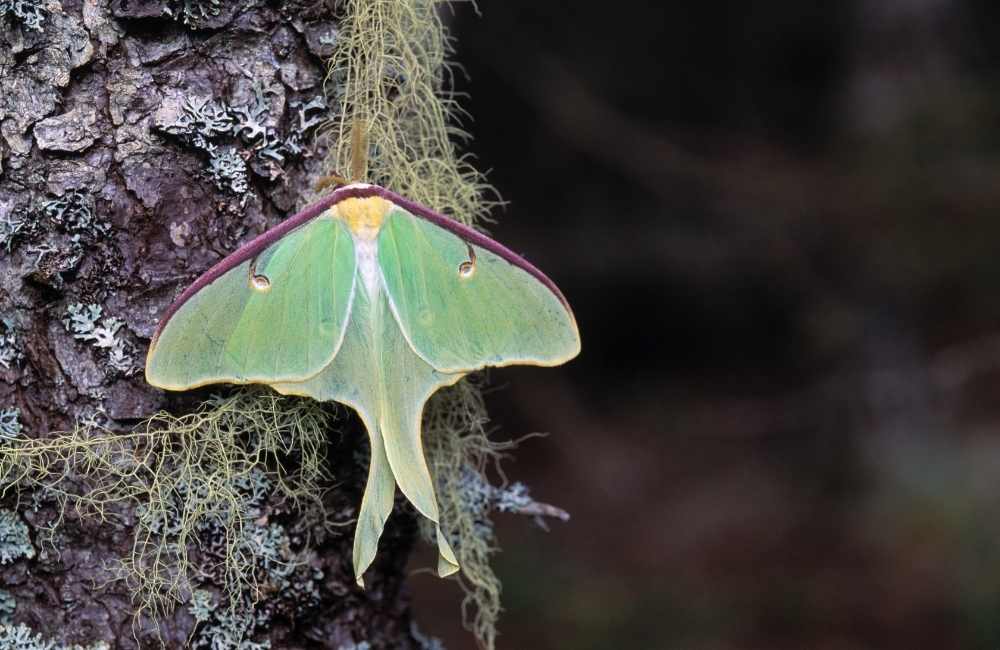
When we think of moths, we often think of the types of moths that eat clothes when they’re in storage or the kinds of moths that flutter around bright lights.
In this article, we will introduce you to a different type of moth: the luna moth!
These bright green creatures are beautiful to look at and hard to spot in the wild.
We’ll take you through descriptions of what these moths look like, what they eat, and how they transform from caterpillars into moths.
Let’s get right into it.
Luna Moth Appearance
Both females and male luna moths / adult luna moths look pretty similar to one another. They have green wings and hairy white bodies. Male and female lunar moths also have eyespots on their hind wings and their fore wings. In some instances, lunar moths have twisted tails that stretch out from the back of their hind wings.
Their forewings have a dark-colored edge that narrows in its thickness as the edge moves from the thorax to the tip of the moth’s wing. This dark-colored edge usually ranges from brown to dark maroon.
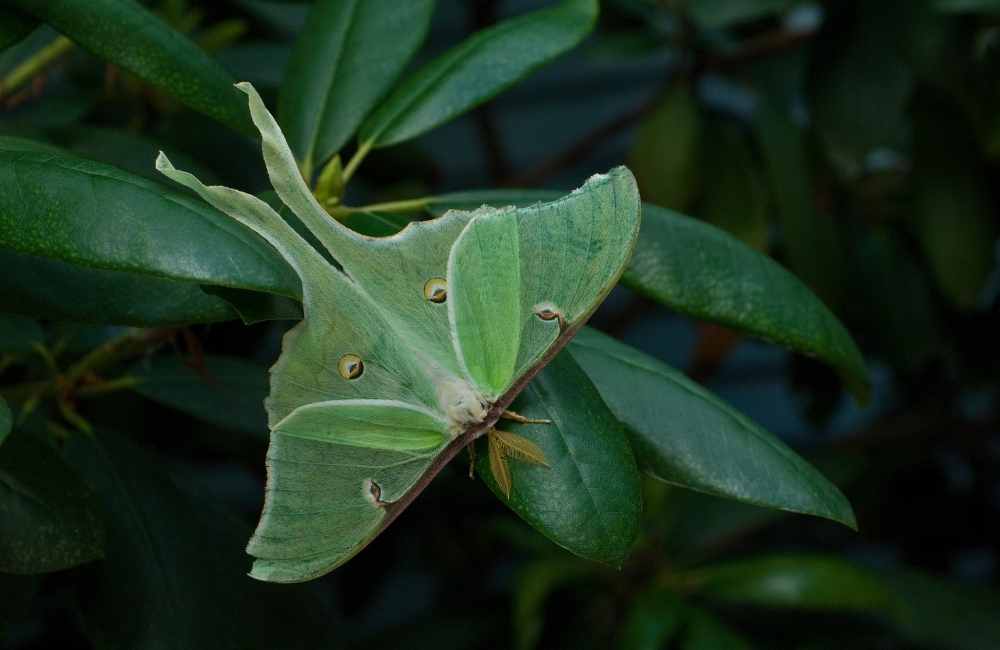
It’s important to remember that the eyespots on the moth’s wing have two different shapes: an oval on the forewing and a circle on the hind wing. The eyespots are usually filled with colored arcs, typically black, red, green, yellow, white, or blue. Scientists believe that these eyespots confuse predators.
How Big do Luna Moths get?
When an adult luna moth emerges from the pupae, its wings are tiny and crumpled. However, after a few hours of emerging, the luna moth’s wings get bigger and eventually become full-sized. The average wingspan of a lunar moth is anywhere between 8-11.5 centimeters. In some cases, researchers have found that some luna moths have a wingspan of over 17 centimeters.
Where do Luna Moths live?
Luna moths are generally found across North America, mainly from Florida to Maine and in Saskatchewan. Luna moths can also be found in the central regions of Quebec and Nova Scotia in Canada.
While it is rare to find them, there have been some instances where researchers have found vagrant luna moths in some parts of Europe.
What do Luna Moths eat?
When luna moths are caterpillars, they eat walnut leaves, persimmons, sweetgum, sumacs, and pecans. They also enjoy eating hickories and butternut.
However, adult luna moths do not have mouths, and therefore, they do not eat.
Do Moths have mouths?
While some types of moths have mouths, the luna moth is one type of moth that does not have a mouth. During the stage of transformation from a caterpillar to a moth, their mouthparts reduce, and as a result, they cannot eat as adults. However, it’s important to remember that luna moths live off the food stored when they were in the adult caterpillar stage. Unfortunately, the fact that moths lack mouths means that they live for a very short amount of time.
How long do luna moths live?
Luna moths do not live for very long. The average lifespan of a luna moth is one week. Its lifespan is so short because the luna moth does not have a mouth, and therefore it does not eat.
Breeding in Luna Moths
Since the average lifespan of a luna moth is so short, it must spend its last days mating and procreating. After the moth emerges from its cocoon and its wings are able to fly, the luna moth sets out to find a mate to breed with. When a female luna moth finds a male partner, it releases a pheromone that attracts a male moth.
After mating, the female luna moth will lay over 200 eggs on a leaf.
Luna Moth Life Cycle
The life cycle of a luna moth is quite interesting. If you’re familiar with the way a caterpillar transforms into a butterfly, then you will understand the way a moth transforms from a caterpillar into a moth as well!
Let’s take a closer look at the life cycle of a luna moth.
Luna Moth Eggs
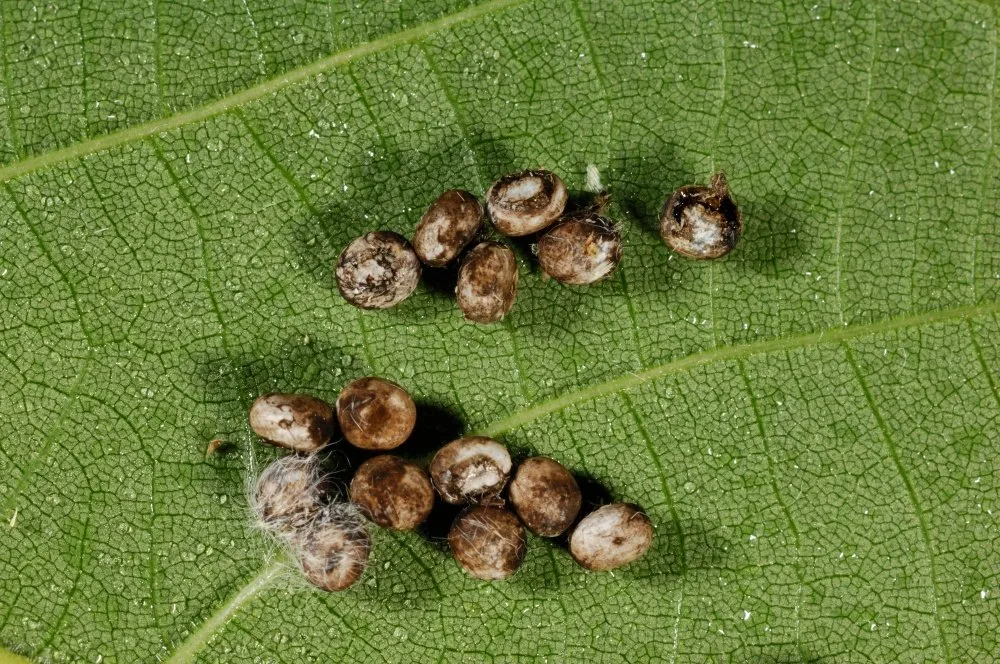
After a pair of luna moths mate, the female typically lays around 200-400 eggs either in small groups or singly. She usually lays these groups on the underside of the leaves on which the male and female moth mated. It’s important to note that the larvae generally prefer the species of leaves the eggs are laid on.
Please remember that the female luna moth will lay the eggs in the evening on the same day the mating occurs. The process of laying eggs can sometimes take many days to complete.
Luna Moth Cocoon/Larvae
The instar period begins once the eggs are laid. Instar refers to the period of time between molts, and it can take anywhere from four to ten days.
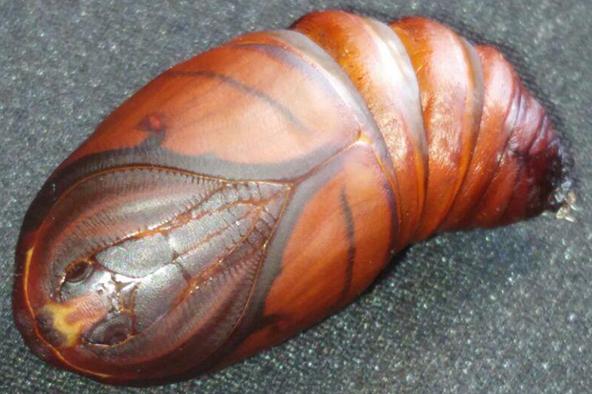
It is important to note that there are five instars before the larvae turn into a cocoon. After each instar ends, the larva goes through the process of apolysis and then ecdysis. It’s also important to remember that a small amount of silk is placed on the leaf’s primary vein after each instar phase. When the larvae are going apolysis and ecdysis, it is leaving their old exoskeleton behind. In some cases, it eats the exoskeleton that is shed.
Ecdysis is also known as molting.
The instar is green at every stage, but you must remember that the first two instars often have black spots on the dorsal side in some larvae.
When the final instar stage occurs, the instar grows to over two inches or roughly 70mm to 90mm in length. This species of instar is tree-dwelling, which means that larvae live on the same tree that they hatched. When the time comes to leave the tree and make a cocoon, they will go to the ground and make their cocoons.
After female luna moths emerge from the cocoons, they will fly to their preferred species of tree and wait for a male moth to join them after they emit pheromones.
When the luna moth descends to the ground to build a cocoon, it does so by spinning a silk cocoon. The cocoon is very thin and has a single layer. Right before the process of pupation takes place, the fifth-instar caterpillar will eject all of the contents in its gut. These contents include excess water and other solid food.
Luna moths are a lot more active than other moths while they are in the cocoon. They tend to wiggle in their pupal cases if they are disturbed. The process of pupation takes around two weeks to complete. If the moth is in a state of diapause during the winter months, the pupation stage takes over nine months to complete.
Luna Moth Caterpillar
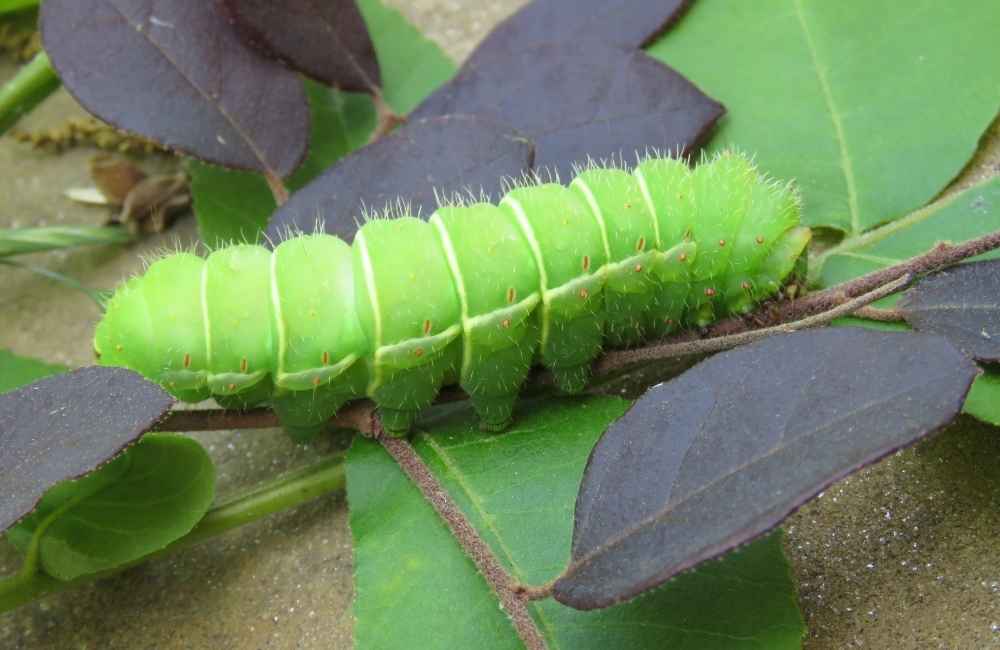
Luna moth caterpillars are beautiful bright green caterpillars. They have red and orange spots all over their bodies and yellow lines along the sides of their bodies. When a luna moth caterpillar is fully grown, it is usually just under three inches long, meaning around 2.75 inches or 70mm long.
Before the caterpillar builds itself a cocoon, it turns from a brightly colored green caterpillar into a dark red or amber-colored caterpillar.
As the luna moth caterpillar goes through its different instar stages, the amount of body hair and the color of its body vary greatly.
What do Luna Moth Caterpillars eat?
Luna moth caterpillars eat a variety of different plants. These include pecans, persimmons, sweetgum, sumacs, and walnut leaves. They also eat hickories.
Are Luna Moth Caterpillars dangerous?
No, luna moth caterpillar and luna moth are not dangerous. While you might think that these moths and caterpillars are harmful or dangerous because of their brightly colored bodies, you don’t have to worry about getting injured or killed because they are completely harmless creatures.
Still, it’s important to note that luna moth do have tiny hairs on their wings and bodies, which can cause some irritation or allergic reactions. However, these reactions are often minor and do not cause any lasting damage. The hairs on the luna moth’s body are not strong or powerful enough to penetrate the skin, and they do not contain harmful toxins that can be fatal.
Luna moth and luna moth caterpillars cannot sting you either.
Luna Moth Imago
The pupae transform into winged moths after they get signals alerting them about temperature changes. After the adult moth emerges from the cocoon, they have small and soft wings. Their wings are also extremely wet. They will have swollen abdomens too.
Once the moth emerges as an adult moth, its body must make lots of adjustments.
Its body will spend its first few hours pumping hemolymph into the moth’s wings. Hemolymph is the invertebrates’ version of blood. After the moth’s wings dry and harden, it can fly. The process of waiting for its wings to dry takes over 2-3 hours to finish.
If you ever see a luna moth, consider yourself lucky! Luna moth often seen quite rarely because of how short their adult lives are. They are also nocturnal creatures that tend to fly at night.
Types of Luna Moth
Luna moth belong to the Actias genus, which means that there are different types of luna moth. Some of them are:
- The Chinese luna moth, or Actias Dubernardi
- The Andaman moon moth, or Actias Callandra
- The celestial moon moth, or the Actias Chapae
- The Japanese moon moth, or Actia Gnoma
- The Malaysian moon moth or Actias maenas
- The Pink spirit moth or Actias rhodopneuma
- The Indian moon moth or Actias Selene
Chinese Luna Moth
The Chinese luna moth, or Actias Dubernardi, was discovered in the last 1800s by Charles Oberthur. They take roughly 80 days to transform from an egg into a full-grown adult luna moth. These moths live for 10-12 days.
Brown Luna Moth
Brown luna moth are commonly found during the summer months. They belong to the larger Saturniidae family, which contains a few of the largest moths specie all over the world. These moths have a wingspan of 1-6 inches with brightly colored spots on their wings. They are the largest moths because of their wings.
Luna Moth Predators and Parasites
One of the most common predators of luna moth is bats. In terms of parasites, the fly known as Compsilura concinnata has proved to cause damage to the luna moth population.
Luna Moth Defenses
Luna moth defend themselves by rubbing their serrated mandibles together. Their mandibles make a clicking noise that predators and humans alike can hear. They also regurgitate the contents of their intestines to ward off predators.
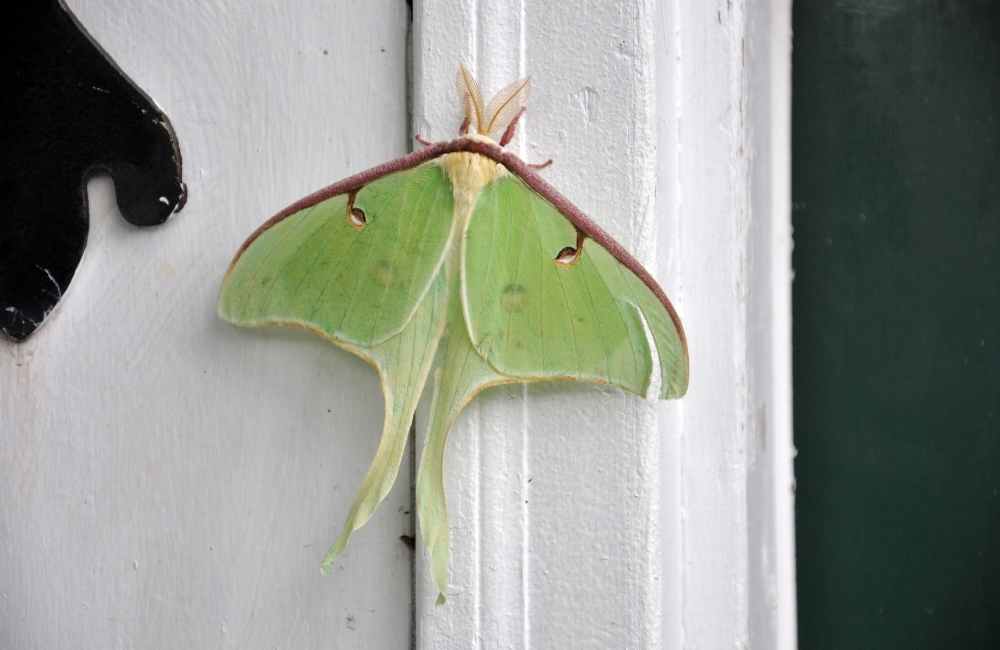
Are Luna Moths in Danger?
While it is rare to see luna moth in nature, they are not an endangered species, and they are not at risk of becoming extinct soon.
Luna Moth Host Plants
Luna moth larvae typically feed on plants like American sweetgum and American persimmon, along with white birch, various types of walnut, sumac, and hickory.
Interesting Facts About Luna Moth
- Luna moths are the only moths to be featured on postage stamps in the United States of America.
- Luna moths are featured in the popular video game Elder Scrolls V: Skyrim. They are one of many alchemy ingredients that you will find in the game.
